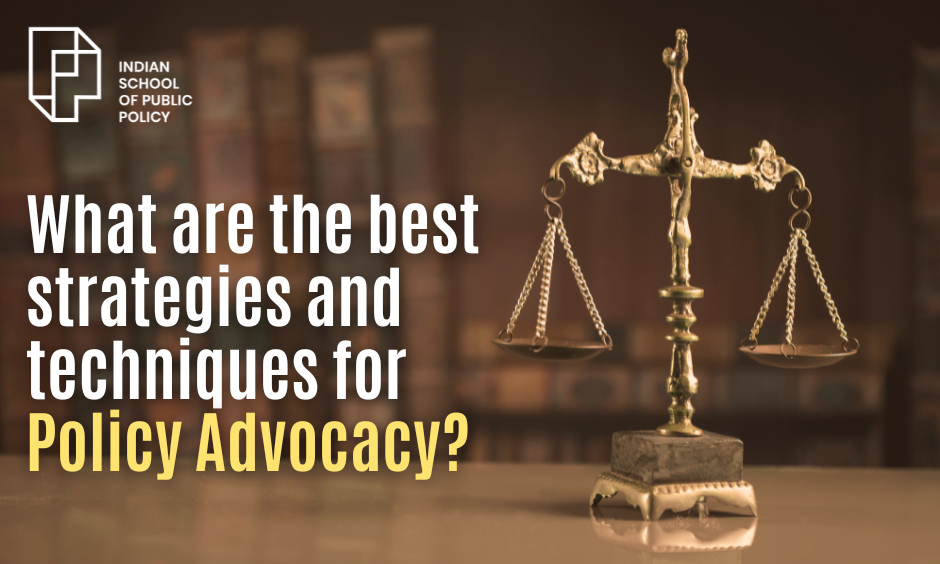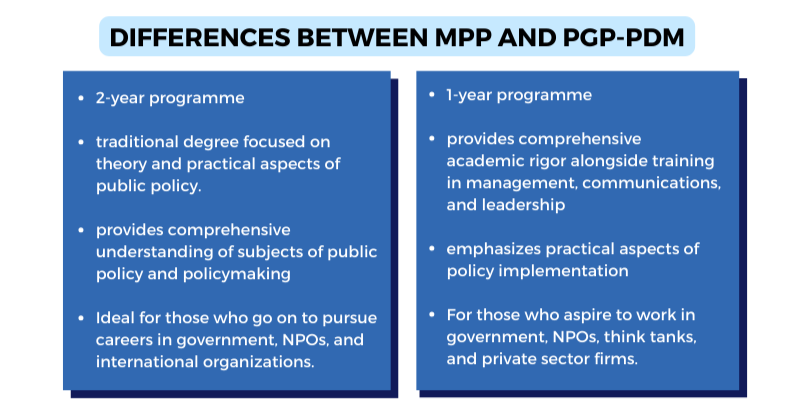
What are the best strategies and techniques for Policy Advocacy?

Understand the nitty-gritty of Public Advocacy through an MPP or a PDM programme!
Best Strategies and Techniques for Effective Policy Advocacy
Policy advocacy is pivotal in driving social, economic, and political change. In a world where Public Policies shape our everyday lives, the ability to influence these policies is more critical than ever. But what exactly is policy advocacy, and how can one effectively engage in it? Read further to discover the best strategies and techniques for effective policy advocacy, providing a roadmap for anyone looking to make a meaningful impact.
Understanding Policy Advocacy
Policy advocacy refers to the efforts of individuals or organisations to influence Public Policy in favour of a particular cause or issue. It encompasses a range of activities, from lobbying and public campaigns to grassroots mobilisation and coalition-building.
Policy advocacy is essential for shaping Public Policy and driving change. It allows citizens and organisations to have a voice in the decision-making process, ensuring that policies reflect the community’s needs and values. Effective policy advocacy can bring significant social, economic, and political improvements.
Key Strategies for Effective Policy Advocacy
➤Building Coalitions and Alliances: Coalition-building is critical in policy advocacy. By partnering with like-minded organisations, advocates can pool resources, share expertise, and amplify their voices. Identifying potential partners and establishing strong, collaborative relationships is key to successful coalition-building.
In 2013, a coalition of various environmental organisations in India came together to form the Climate & Clean Air Network (CCAC) to address the growing issue of air pollution in major cities. This coalition included NGOs, research institutions, and grassroots organisations working towards a common goal. By pooling their resources and expertise, the coalition was able to amplify their advocacy efforts, conducting joint research studies and public awareness campaigns. They successfully lobbied the government to implement stricter air quality standards and promote the use of cleaner technologies. This collective effort led to significant policy changes and heightened public awareness about air pollution. |
➤Research and Data-Driven Advocacy: Thorough research and data are the backbone of effective policy advocacy. Advocates need to gather and utilise data to support their arguments and demonstrate the impact of proposed policies. Techniques for effective data gathering include conducting surveys, analysing existing research, and collaborating with academic institutions.
➤Engaging Stakeholders: Identifying and engaging key stakeholders is crucial. Stakeholders include anyone affected by or interested in the policy issue, such as community members, business leaders, and policymakers. Strategies for effective stakeholder engagement include organising meetings, creating communication channels, and fostering open dialogue.
➤Grassroots Mobilisation: Grassroots movements play a vital role in policy advocacy. Mobilising grassroots support involves rallying community members to participate in advocacy efforts, such as signing petitions, attending rallies, and contacting their representatives. This bottom-up approach can create significant pressure on policymakers to take action.
| Case study: The Narmada Bachao AndolanThe Narmada Bachao Andolan (NBA) is a grassroots movement in India that began in the mid-1980s to oppose the construction of large dams on the Narmada River. The movement effectively mobilised local communities through public rallies, protests, and extensive community engagement, drawing national and international attention to the displacement of indigenous people and environmental concerns caused by the dam projects. |
➤Media and Communication Strategies: The media is a powerful tool in policy advocacy. Advocates can leverage traditional and social media to raise awareness, shape public opinion, and put pressure on policymakers. Techniques include writing op-eds, engaging with journalists, and using social media platforms to reach a broader audience.
In 2017, the Indian campaign for menstrual hygiene, spearheaded by the NGO Myna Mahila Foundation, utilised media and communication strategies to great effect. The campaign aimed to break the stigma around menstruation and improve menstrual hygiene management in rural areas. By leveraging both traditional media, like television and newspapers, and social media platforms, the campaign reached a wide audience. They produced compelling narratives, including personal stories of women affected by poor menstrual hygiene, and created engaging content such as videos and infographics. This media blitz not only raised awareness but also influenced policymakers to provide better menstrual hygiene facilities and education. The campaign’s success was further highlighted when it received international recognition, including support from prominent figures like Meghan Markle. |
➤Lobbying and Direct Advocacy: Lobbying involves direct interaction with policymakers to influence their decisions. This can include meetings, phone calls, and written communications. Effective lobbying requires a deep understanding of the policy issue, the political landscape, and the interests of the policymakers.
Techniques for successful Policy Advocacy
➤Storytelling: Storytelling is a powerful technique in advocacy. By sharing personal stories and real-life examples, advocates can humanise the issue and make it more relatable. Compelling narratives can evoke empathy and drive action.
➤Policy Briefs and Position Papers: Well-written policy briefs and position papers are essential tools for advocates. These documents succinctly outline the issue, provide evidence-based arguments, and recommend specific policy actions. Tips for creating impactful policy documents include clarity, conciseness, and a strong evidence base.
➤Public Campaigns and Awareness Drives: Public campaigns and awareness drives are effective ways to build support for a policy issue. Techniques for running successful campaigns include defining clear goals, identifying the target audience, and using a mix of communication channels to reach that audience.
➤Workshops and Training Sessions: Capacity building is vital for sustainable advocacy efforts. Organising workshops and training sessions can equip advocates with the skills and knowledge they need to be effective. This includes training on research methods, communication strategies, and lobbying techniques.
Challenges in Policy Advocacy
➤Common Obstacles: Advocates often face several challenges, including limited resources, political resistance, and public apathy. These obstacles can hinder advocacy efforts and make it difficult to achieve policy change.
➤Overcoming Challenges: To address these challenges, advocates can employ strategies such as building strong networks, securing funding, and raising public awareness. Persistence and adaptability are also crucial in overcoming obstacles.
➤The Dire Need for Highly Skilled Policymakers: It is imperative to have highly qualified and experienced policymakers who can identify gaps in the current system and offer solutions to overcome these hurdles. Skilled policymakers are essential for effective policy advocacy and ensuring that policies are well-informed and beneficial to society.
Conclusion
Policy advocacy is a powerful tool for driving social, economic, and political change. By employing strategies such as coalition-building, data-driven advocacy, stakeholder engagement, grassroots mobilisation, and effective communication, advocates can significantly influence Public Policy. For those aspiring to make an impact, upskilling themselves and pursuing formal education, such as a Master’s in Public Policy or the Postgraduate Programme in Public Policy, Design, and Management, can provide valuable knowledge and skills.
Master’s in Public Policy (MPP) or the Postgraduate Programme in Public Policy, Design, and Management (PDM)
The Master’s in Public Policy (MPP) programme delves into the intricacies of government policies and their effects on society. It provides students with a robust foundation for implementing, analysing, and evaluating Public Policies. Graduates often embark on careers in government, nonprofits, or international organisations. The Post Graduate Programme (PGP) in Public Policy in India aims to enhance students’ policy-making skills and the effective implementation of Public Policies. This programme equips students with various roles within the field. Its curriculum covers subjects such as economics, political science, and law, with a strong emphasis on analytical skills and research methodologies. Graduates are thoroughly prepared to assess policy issues and develop evidence-based solutions. When choosing your programme, it is essential to consider the admission criteria and career opportunities each offers.

Although both programmes are highly regarded, the Indian School of Public Policy (ISPP) holds a distinct advantage. Why, you might ask?
Why should you pursue the Post Graduate Programme in Public Policy, Design, and Management by ISPP?
The programme delivers a comprehensive understanding of Public Policy and formulation, equipping students with essential design and management principles. Its objective is to develop proficient systems thinkers and policy executives.
- Harris UChicago: Credential in Public Policy
- Immersive Learning Engagement
- Interactive Labs
- Tea & Policy
Register your Interest to Study at ISPP
Interested? Apply now!!
FAQS
What is policy advocacy?
Policy advocacy refers to efforts to influence Public Policy in favour of a particular cause or issue through activities like lobbying, public campaigns, and grassroots mobilisation.
Why is coalition-building important in policy advocacy?
Coalition-building is important because it allows advocates to pool resources, share expertise, and amplify their voice, making their efforts more impactful.
How can data be effectively used in policy advocacy?
Data can be used to support arguments, demonstrate the impact of policies, and persuade stakeholders. Techniques include conducting surveys, analysing existing research, and collaborating with academic institutions.
What are some effective media strategies for advocacy?
Effective media strategies include writing op-eds, engaging with journalists, and using social media platforms to raise awareness and shape public opinion.
How can storytelling enhance policy advocacy efforts?
Storytelling can humanise an issue and make it more relatable, evoking empathy and driving action. Personal stories and real-life examples are powerful tools in advocacy.
What are the common challenges in policy advocacy?
Common challenges include limited resources, political resistance, and public apathy. Overcoming these challenges requires strong networks, funding, public awareness, persistence, and adaptability.


